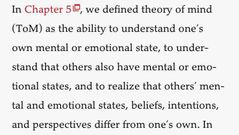![]()
![]()
![]()
Use LEFT and RIGHT arrow keys to navigate between flashcards;
Use UP and DOWN arrow keys to flip the card;
H to show hint;
A reads text to speech;
12 Cards in this Set
- Front
- Back
|
ASHA definition of “language” |
A complex and dynamic system of conventional symbols that is used in various modes for thought and communication |
|
|
Morpheme |
The smallest unit of language that carries meaning |
|
|
Communication |
The process of sharing information among two or more persons |
|
|
Three divisions of the brain |
Cerebrum Brainstem Cerebellum |
|
|
Nativist-Empiricist Debate |
Nature versus Nurture Debate |
|
|
Theory of Mind |

Back (Definition) |
|
|
Fluency |
Reading that is efficient, well-paced, and free of errors |
|
|
Ungluing from Print |
The idea that as children become more confident and fluent in their reading abilities their reading becomes more automatic. So they can focus less on the print itself and more on gaining meaning from the text |
|
|
Infants’ speech perception ability |
Their ability to devote attention to the prosodic and phonetic regularities of speech; develops tremendously in the first year |
|
|
prosodic characteristics of speech |
F.I.D. (frequency, intensity, duration) The combination of these factors produces the distinguishable stress & intonation patterns that infants can detect. |
|
|
stress |
the prominence placed on certain syllables of multisyllabic words |
|
|
intonation |
the prominence placed on certain syllables of phrases and sentences (In phonetics, we learned that intonation was the rising/falling quality of an utterance.) |

